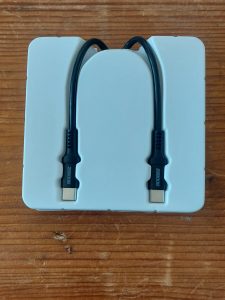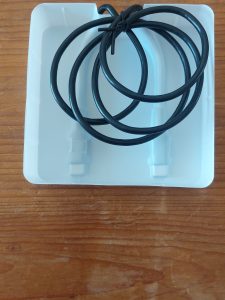This day last week was International Women’s Day. This week, I received from my employer, very generously, a piece of equipment on loan. Unwrapping it sparked a happy feeling, but immediately afterwards also a very sad one.
The equipment came with the following:
The ends of this cable were snugly fitted in their little pre-shaped beds at the bottom, and, at the top, folded elegantly towards the back of the packaging, where they met each other in an equally neatly wrapped coil that again fitted perfectly in the plastic mould.
It gave me great pleasure to see these shapes and how they worked together; to click the cable from its position, and back again in order to take the photo. I suspect that the enjoyment we can get from such shapes is to do partly with seeing and feeling that something fits well – works well. And partly with feeling a little bit like we ourselves are inside a well-tucked bed.
This was the happy feeling.
The sad feeling followed immediately after that. Because, as my fingers took the cable from its bed, I imagined the fingers that, perhaps a few months ago, must have placed the cable into its bed.* And how these fingers must be putting, not one cable, but perhaps several thousands of cables into their boxes every single day. And I imagined the owner of these fingers. Perhaps you who read this are this person. Or perhaps you have another repetitive job. The kind of job where your hands perform the same movement every few seconds for hours on end, and most of the rest of your body has to keep still.
Globally, it has for a long time often been people gendered female who get and keep such repetitive jobs, in electronics, textiles, data entry, food processing and, most of all, agriculture. The proportion of women in these sectors has been declining, and they may be overtaken by men soon: see the ILO report Women at Work (p. 24). Still, however, research using the ‘routine task intensity index’ (RTI index) suggests that women globally currently perform more routine work: see the report Quantum Leap (p. 49). So, if you have a high-routine job, likely you are woman, perhaps man, perhaps neither or both. Whichever way, you probably share a lot of experiences with others engaged in routine-intensive work.
I myself have had jobs like this, though only for very brief periods. The feeling associated with such tasks, for me at least, was not pleasure at all, but pain. The satisfaction of perfectly fitting components was absent, and the dominant sensation was pain. Literal, physical pain, in fingers, arms, eyes… and also what I can only describe as pain in the brain. I quit these jobs as soon as I could.
My unwrapping pleasures only put the wrapping-up pain that I imagine to have been there into starker relief. No one should have to do such fast and repetitive work as factories across the world force people to do. The alternative, of course, should not be automation and job loss, as is now often the threat, but healthier work.
I am doing my best not to be unwrapping new equipment from pleasant boxes many times in my life any more. Plenty of other nicely-fitting-things in the world!
* For my story, it does not matter whether mechanisation has developed far enough already for a machine to be able to put this cable into this particular box or not. There will be people employed in similar actions for a while to come.



